Characterization and Optimal Design of Silicon-Rich Nitride Nonlinear Waveguides for 2 μm Wavelength Band
Abstract
1. Introduction
2. Structure and Fabrication
3. Linear and Nonlinear Characterizations
3.1. Linear Characterizations
3.2. Nonlinear Characterizations
4. Optimal Design for the Maximal Nonlinear Energy Efficiency
5. Optimal Design for a Superbroad FWM Conversion Bandwidth
6. Discussion and Conclusions
Author Contributions
Funding
Conflicts of Interest
References
- Gunning, F.; Corbett, B. Time to Open the 2-μm Window? Opt. Photonics News 2019, 30, 42–47. [Google Scholar] [CrossRef]
- Su, Y.; Wang, W.; Hu, X.; Hu, H.; Huang, X.; Wang, Y.; Si, J.; Xie, X.; Han, B.; Feng, H.; et al. 10 Gbps DPSK transmission over free-space link in the mid-infrared. Opt. Express 2018, 26, 34515–34528. [Google Scholar] [CrossRef] [PubMed]
- Tuan, T.H.; Nishiharaguchi, N.; Suzuki, T.; Ohishi, Y. Mid-infrared transmission by a tellurite hollow core optical fiber. Opt. Express 2019, 27, 30576–30588. [Google Scholar] [CrossRef]
- Lamy, M.; Finot, C.; Fatome, J.; Arocas, J.; Weeber, J.-C.; Hammani, K. Demonstration of High-Speed Optical Transmission at 2 µm in Titanium Dioxide Waveguides. Appl. Sci. 2017, 7, 631. [Google Scholar] [CrossRef]
- Lee, E.; Luo, J.; Sun, B.; Ramalingam, V.L.; Yu, X.; Wang, Q.; Yu, F.; Knight, J.C. 45W 2 µm nanosecond pulse delivery using antiresonant hollow-core fiber. In Proceedings of the Conference on Lasers and Electro-Optics: Science and Innovations, San Jose, CA, USA, 13–18 May 2018. [Google Scholar]
- Kong, D.; Liu, Y.; Ren, Z.; Jung, Y.; Pu, M.; Yvind, K.; Galili, M.; Oxenløwe, L.K.; Richardson, D.J.; Hu, H. Generation and Coherent Detection of 2-µm-band WDM-QPSK Signals by On-chip Spectral Translation. In Proceedings of the Optical Fiber Communication Conference (OFC), San Diego, CA, USA, 8–12 March 2020. [Google Scholar]
- Li, Z.; Heidt, A.M.; Daniel, J.M.O.; Jung, Y.; Alam, S.U.; Richardson, D.J. Thulium-doped fiber amplifier for optical communications at 2 μm. Opt. Express 2013, 21, 9289–9297. [Google Scholar] [CrossRef]
- Agrawal, G.P. Nonlinear Fiber Optics, 3rd ed.; Academic: Boston, MA, USA, 2001. [Google Scholar]
- Geng, J.; Wang, Q.; Jiang, S. 2μm fiber laser sources and their applications. In Proceedings of the NanOphotonics and Macrophotonics for Spacel Envgineering + Applicationments V, San Diego, CA, USA, 13 September 2011. [Google Scholar]
- Yang, C.-A.; Xie, S.-W.; Zhang, Y.; Shang, J.-M.; Huang, S.-S.; Yuan, Y.; Shao, F.-H.; Zhang, Y.; Xu, Y.; Niu, Z.-C. High-power, high-spectral-purity GaSb-based laterally coupled distributed feedback lasers with metal gratings emitting at 2 μm. Appl. Phys. Lett. 2019, 114, 021102. [Google Scholar] [CrossRef]
- Cao, W.; Hagan, D.; Thomson, D.J.; Nedeljkovic, M.; Littlejohns, C.G.; Knights, A.; Alam, S.-U.; Wang, J.; Gardes, F.Y.; Zhang, W.; et al. High-speed silicon modulators for the 2 μm wavelength band. Optica 2018, 5, 1055–1062. [Google Scholar] [CrossRef]
- Richardson, D.J. New optical fibres for high-capacity optical communications. Philos. Trans. R. Soc. A Math. Phys. Eng. Sci. 2016, 374, 20140441. [Google Scholar] [CrossRef]
- Ryckeboer, E.; Gassenq, A.; Muneeb, M.; Hattasan, N.; Pathak, S.; Cerutti, L.; Rodriguez, J.; Tournié, E.; Bogaerts, W.; Baets, R.; et al. Silicon-on-insulator spectrometers with integrated GaInAsSb photodiodes for wide-band spectroscopy from 1510 to 2300 nm. Opt. Express 2013, 21, 6101–6108. [Google Scholar] [CrossRef]
- Liu, Y.; Li, Z.; Li, D.; Yao, Y.; Du, J.; He, Z.; Xu, K. Thermo-Optic Tunable Silicon Arrayed Waveguide Grating at 2-μm Wavelength Band. IEEE Photonics J. 2020, 12, 1–8. [Google Scholar] [CrossRef]
- Wang, R.; Vasiliev, A.; Muneeb, M.; Malik, A.; Sprengel, S.; Boehm, G.; Amann, M.-C.; Šimonytė, I.; Vizbaras, A.; Vizbaras, K.; et al. III–V-on-silicon photonic integrated circuits for spectroscopic sensing in the 2–4 μm wavelength range. Sensors 2017, 17, 1788. [Google Scholar] [CrossRef] [PubMed]
- Xu, S.; Wang, W.; Huang, Y.-C.; Dong, Y.; Masudy-Panah, S.; Wang, H.; Gong, X.; Yeo, Y.-C. High-speed photo detection at two-micron-wavelength: Technology enablement by GeSn/Ge multiple-quantum-well photodiode on 300 mm Si substrate. Opt. Express 2019, 27, 5798–5813. [Google Scholar] [CrossRef]
- Leuthold, J.; Koos, C.; Freude, W. Nonlinear silicon photonics. Nat. Photonics 2010, 4, 535–544. [Google Scholar] [CrossRef]
- Espinola, R.L.; Dadap, J.I.; Osgood, J.R.M.; McNab, S.J.; Vlasov, Y.A. C-band wavelength conversion in silicon photonic wire waveguides. Opt. Express 2005, 13, 4341–4349. [Google Scholar] [CrossRef]
- Lin, Q.; Painter, O.J.; Agrawal, G.P. Nonlinear optical phenomena in silicon waveguides: Modeling and applications. Opt. Express 2007, 15, 16604–16644. [Google Scholar] [CrossRef] [PubMed]
- Moss, D.J.; Morandotti, R.; Gaeta, A.L.; Lipson, M. New CMOS-compatible platforms based on silicon nitride and Hydex for nonlinear optics. Nat. Photonics 2013, 7, 597–607. [Google Scholar] [CrossRef]
- Blumenthal, D.J.; Heideman, R.; Geuzebroek, D.; Leinse, A.; Roeloffzen, C.G.H. Silicon Nitride in Silicon Photonics. Proc. IEEE 2018, 106, 2209–2231. [Google Scholar] [CrossRef]
- Bristow, A.D.; Rotenberg, N.; Van Driel, H.M. Two-photon absorption and Kerr coefficients of silicon for 850–2200nm. Appl. Phys. Lett. 2007, 90, 191104. [Google Scholar] [CrossRef]
- Soref, R.; Emelett, S.J.; Buchwald, W.R. Silicon waveguided components for the long-wave infrared region. J. Opt. A Pure Appl. Opt. 2006, 8, 840–848. [Google Scholar] [CrossRef]
- Lamy, M.; Finot, C.; Colman, P.; Fatome, J.; Millot, G.; Roelkens, G.; Kuyken, B.; Hammani, K. Silicon waveguides for high-speed optical transmissions and parametric conversion around 2 μm. IEEE Photonics Tech. Lett. 2019, 31, 165–168. [Google Scholar] [CrossRef]
- Liu, X.; Jr, R.M.O.; Vlasov, Y.A.; Green, W.M.J. Mid-infrared optical parametric amplifier using silicon nanophotonic waveguides. Nat. Photonics 2010, 4, 557–560. [Google Scholar] [CrossRef]
- Griffith, A.G.; Lau, R.K.W.; Cardenas, J.; Okawachi, Y.; Mohanty, A.; Fain, R.; Lee, Y.H.D.; Yu, M.; Phare, C.T.; Poitras, C.B.; et al. Silicon-chip mid-infrared frequency comb generation. Nat. Commun. 2015, 6, 6299. [Google Scholar] [CrossRef] [PubMed]
- Pfeiffer, M.H.P.; Herkommer, C.; Liu, J.; Morais, T.; Zervas, M.; Geiselmann, M.; Kippenberg, T.J. Photonic Damascene Process for Low-Loss, High-Confinement Silicon Nitride Waveguides. IEEE J. Sel. Top. Quantum Electron. 2018, 24, 1–11. [Google Scholar] [CrossRef]
- Lamy, M.; Finot, C.; Fatome, J.; Weeber, J.C.; Millot, G.; Kuyken, B.; Roelkens, G.; Brun, M.; Labeye, P.; Nicolleti, S.; et al. High speed optical transmission at 2 μm in subwavelength waveguides made of various materials. In Proceedings of the Integrated Photonics Research, Silicon and Nanophotonics, Zurich, Switzerland, 2–5 July 2018. [Google Scholar]
- Lacava, C.; Stankovic, S.; Khokhar, A.Z.; Bucio, T.D.; Gardes, F.Y.; Reed, G.T.; Richardson, D.J.; Petropoulos, P. Si-rich Silicon Nitride for Nonlinear Signal Processing Applications. Sci. Rep. 2017, 7, 1–13. [Google Scholar] [CrossRef]
- Krückel, C.J.; Fülöp, A.; Klintberg, T.; Bengtsson, J.; Andrekson, P.A.; Torres-Company, V. Linear and nonlinear characterization of low-stress high-confinement silicon-rich nitride waveguides: Erratum. Opt. Express 2017, 25, 7443–7444. [Google Scholar] [CrossRef]
- Liu, X.; Pu, M.; Zhou, B.; Krückel, C.J.; Fülöp, A.; Torres-Company, V.; Bache, M. Octave-spanning supercontinuum generation in a silicon-rich nitride waveguide. Opt. Lett. 2016, 41, 2719. [Google Scholar] [CrossRef]
- Ye, Z.; Fülöp, A.; Helgason, Ó.B.; Andrekson, P.A.; Torres-Company, V. Low-loss high-Q silicon-rich silicon nitride microresonators for Kerr nonlinear optics. Opt. Lett. 2019, 44, 3326–3329. [Google Scholar] [CrossRef]
- Mitrovic, M.; Guan, X.; Ji, H.; Oxenløwe, L.K.; Frandsen, L.H. Four-wave mixing in silicon-rich nitride waveguides. In Proceedings of the Frontiers in Optics, San Jose, CA, USA, 18–22 October 2015. [Google Scholar]
- Wang, X.; Guan, X.; Gao, S.; Hu, H.; Oxenløwe, L.K.; Frandsen, L.H. Silicon/silicon-rich nitride hybrid-core waveguide for nonlinear optics. Opt. Express 2019, 27, 23775–23784. [Google Scholar] [CrossRef]
- Ooi, K.J.A.; Ng, D.K.T.; Wang, T.; Chee, A.K.L.; Ng, S.K.; Wang, Q.; Ang, L.K.; Agarwal, A.; Kimerling, L.C.; Tan, D.T.H. Pushing the limits of CMOS optical parametric amplifiers with USRN:Si7N3 above the two-photon absorption edge. Nat. Commun. 2017, 8, 13878. [Google Scholar] [CrossRef]
- Wang, T.; Ng, D.K.T.; Ng, S.-K.; Toh, Y.-T.; Chee, A.K.L.; Chen, G.F.R.; Wang, Q.; Tan, D.T.H. Supercontinuum generation in bandgap engineered, back-end CMOS compatible silicon rich nitride waveguides. Laser Photonics Rev. 2015, 9, 498–506. [Google Scholar] [CrossRef]
- Choi, J.W.; Sohn, B.-U.; Chen, G.F.R.; Ng, D.K.T.; Tan, D.T.H. Soliton-effect optical pulse compression in CMOS-compatible ultra-silicon-rich nitride waveguides. APL Photonics 2019, 4, 110804. [Google Scholar] [CrossRef]
- Sahin, E.; Blanco-Redondo, A.; Xing, P.; Ng, D.K.T.; Png, C.E.; Tan, D.T.H.; Eggleton, B.J. Bragg Soliton Compression and Fission on CMOS-Compatible Ultra-Silicon-Rich Nitride. Laser Photonics Rev. 2019, 13, 1900114. [Google Scholar] [CrossRef]
- Lamy, M.; Finot, C.; Parriaux, A.; Lacava, C.; Bucio, T.D.; Gardes, F.Y.; Millot, G.; Petropoulos, P.; Hammani, K. Si-rich Si nitride waveguides for optical transmissions and toward wavelength conversion around 2 μm. Appl. Opt. 2019, 58, 5165–5169. [Google Scholar] [CrossRef]
- Cheng, M.-C.; Chang, C.-P.; Huang, W.-S.; Huang, R.-S. Ultralow-stress silicon-rich nitride films for microstructure fabrication. Sens. Mater. 1999, 11, 349–358. [Google Scholar]
- Jin, Q.; Lu, J.; Li, X.; Yan, Q.; Gao, Q.; Gao, S. Performance evaluation of four-wave mixing in a graphene-covered tapered fiber. J. Opt. 2016, 18, 075502. [Google Scholar] [CrossRef]
- Yap, K.P.; Delage, A.; Lapointe, J.; Lamontagne, B.; Schmid, J.H.; Waldron, P.; Syrett, B.A.; Janz, S. Correlation of Scattering Loss, Sidewall Roughness and Waveguide Width in Silicon-on-Insulator (SOI) Ridge Waveguides. J. Light. Technol. 2009, 27, 3999–4008. [Google Scholar] [CrossRef]
- Payne, F.P.; Lacey, J.P.R. A theoretical analysis of scattering loss from planar optical waveguides. Opt. Quantum Electron. 1994, 26, 977–986. [Google Scholar] [CrossRef]
- Afshar, S.; Monro, T.M. A full vectorial model for pulse propagation in emerging waveguides with subwavelength structures part I: Kerr nonlinearity. Opt. Express 2009, 17, 2298–2318. [Google Scholar] [CrossRef]
- Tan, D.T.H.; Ooi, K.J.A.; Ng, D.K.T. Nonlinear optics on silicon-rich nitride—A high nonlinear figure of merit CMOS platform [Invited]. Photonics Res. 2018, 6, B50–B66. [Google Scholar] [CrossRef]
- Ebendorff-Heidepriem, H.; Petropoulos, P.; Asimakis, S.; Finazzi, V.; Moore, R.C.; Frampton, K.; Koizumi, F.; Richardson, D.J.; Monro, T.M. Bismuth glass holey fibers with high nonlinearity. Opt. Express 2004, 12, 5082–5087. [Google Scholar] [CrossRef]

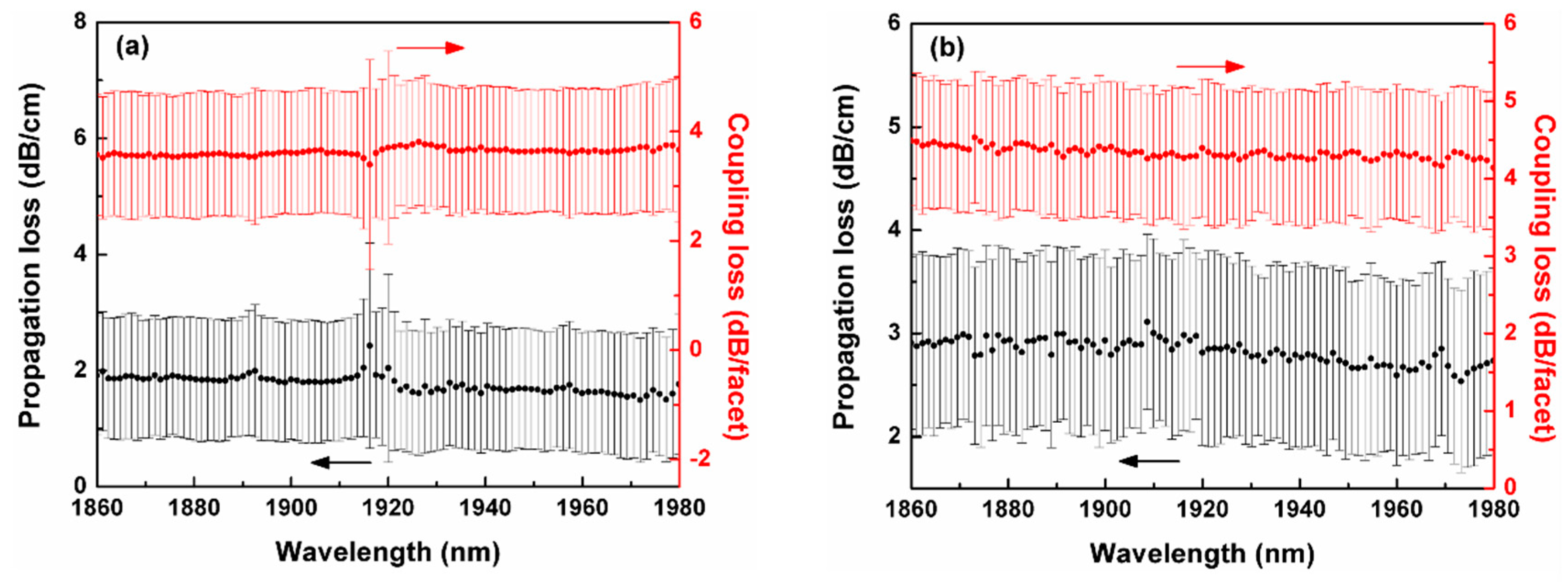
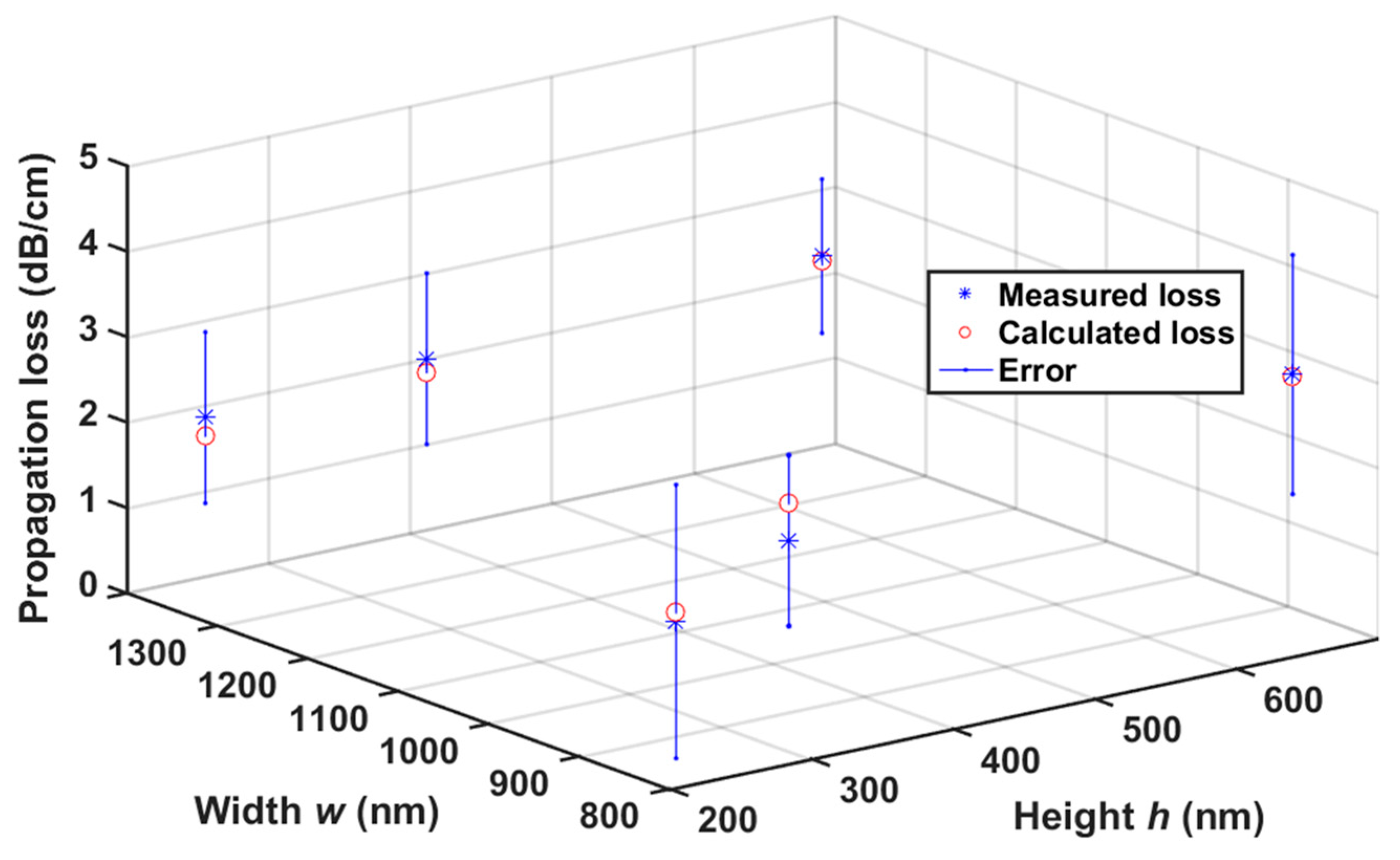

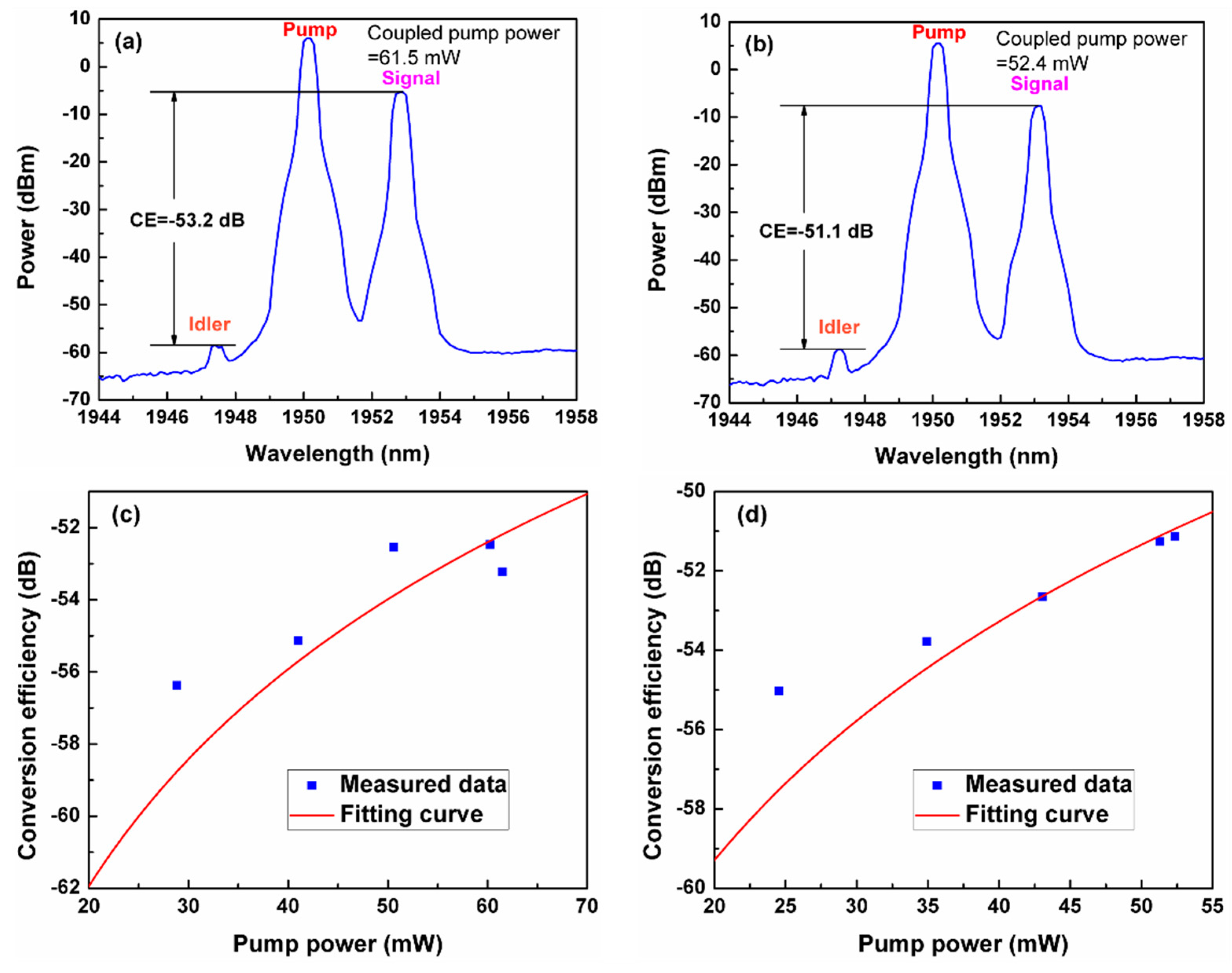
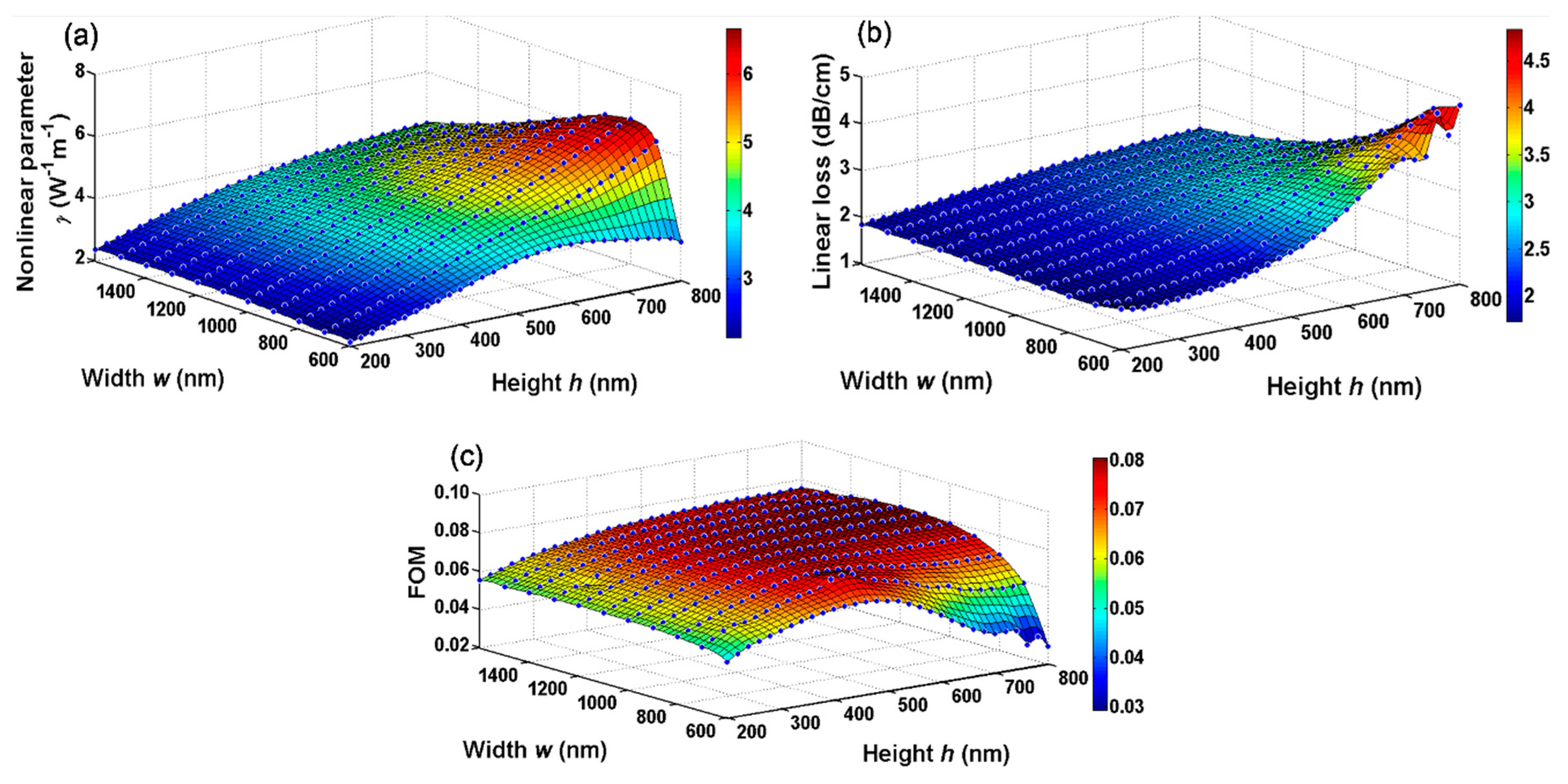
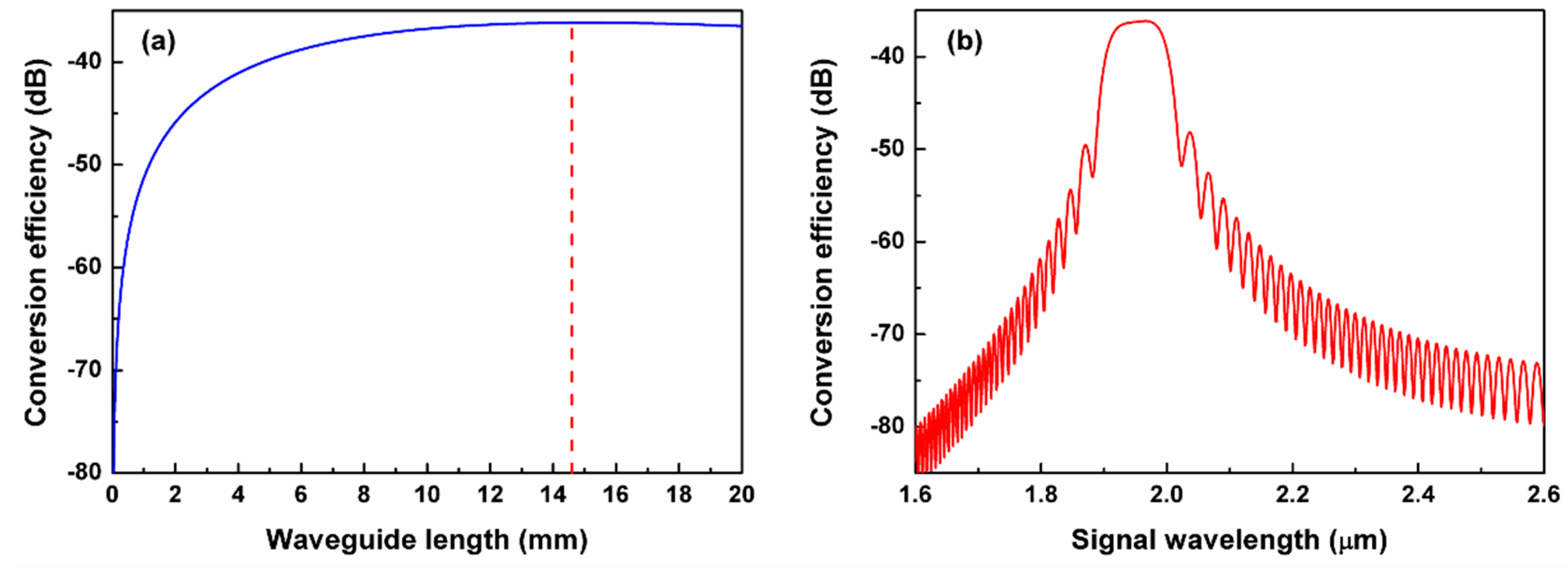
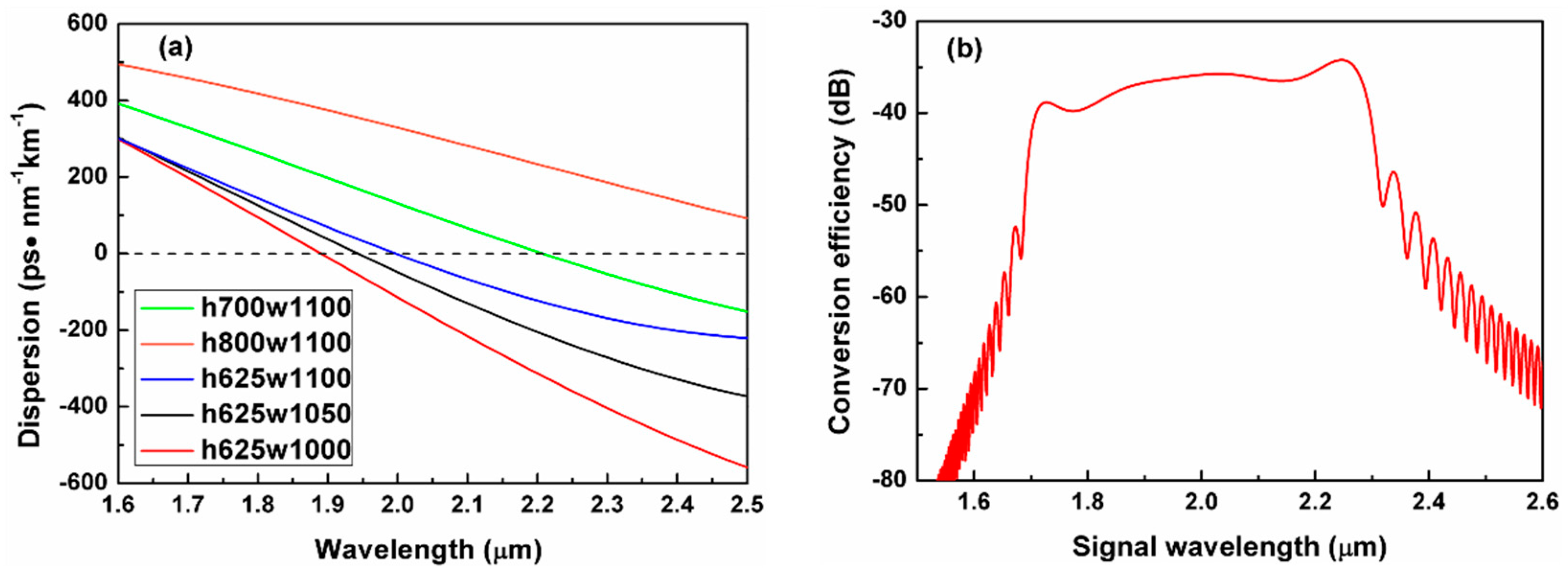
| Measured α (dB/cm) | Calculated α (dB/cm) | γ (W−1 m−1) | n2 (m2/W) | |
|---|---|---|---|---|
| h = 230 nm, w = 840 nm | 1.7 ± 1.6 | 1.8 | 3.74 | 1.77 × 10−18 |
| h = 230 nm, w = 1360 nm | 2.1 ± 1.0 | 1.9 | 2.90 | 1.30 × 10−18 |
| h = 380 nm, w = 950 nm | 1.7 ± 1.0 | 2.1 | 2.79 | 0.87 × 10−18 |
| h = 380 nm, w = 1350 nm | 2.3 ± 1.0 | 2.1 | 2.49 | 0.80 × 10−18 |
| h = 640 nm, w = 800 nm | 3.3 ± 1.4 | 3.3 | 5.98 | 1.24 × 10−18 |
| h = 640 nm, w = 1320 nm | 2.7 ± 0.9 | 2.6 | 4.62 | 1.13 × 10−18 |
Publisher’s Note: MDPI stays neutral with regard to jurisdictional claims in published maps and institutional affiliations. |
© 2020 by the authors. Licensee MDPI, Basel, Switzerland. This article is an open access article distributed under the terms and conditions of the Creative Commons Attribution (CC BY) license (http://creativecommons.org/licenses/by/4.0/).
Share and Cite
Tu, Z.; Chen, D.; Hu, H.; Gao, S.; Guan, X. Characterization and Optimal Design of Silicon-Rich Nitride Nonlinear Waveguides for 2 μm Wavelength Band. Appl. Sci. 2020, 10, 8087. https://doi.org/10.3390/app10228087
Tu Z, Chen D, Hu H, Gao S, Guan X. Characterization and Optimal Design of Silicon-Rich Nitride Nonlinear Waveguides for 2 μm Wavelength Band. Applied Sciences. 2020; 10(22):8087. https://doi.org/10.3390/app10228087
Chicago/Turabian StyleTu, Zhihua, Daru Chen, Hao Hu, Shiming Gao, and Xiaowei Guan. 2020. "Characterization and Optimal Design of Silicon-Rich Nitride Nonlinear Waveguides for 2 μm Wavelength Band" Applied Sciences 10, no. 22: 8087. https://doi.org/10.3390/app10228087
APA StyleTu, Z., Chen, D., Hu, H., Gao, S., & Guan, X. (2020). Characterization and Optimal Design of Silicon-Rich Nitride Nonlinear Waveguides for 2 μm Wavelength Band. Applied Sciences, 10(22), 8087. https://doi.org/10.3390/app10228087









